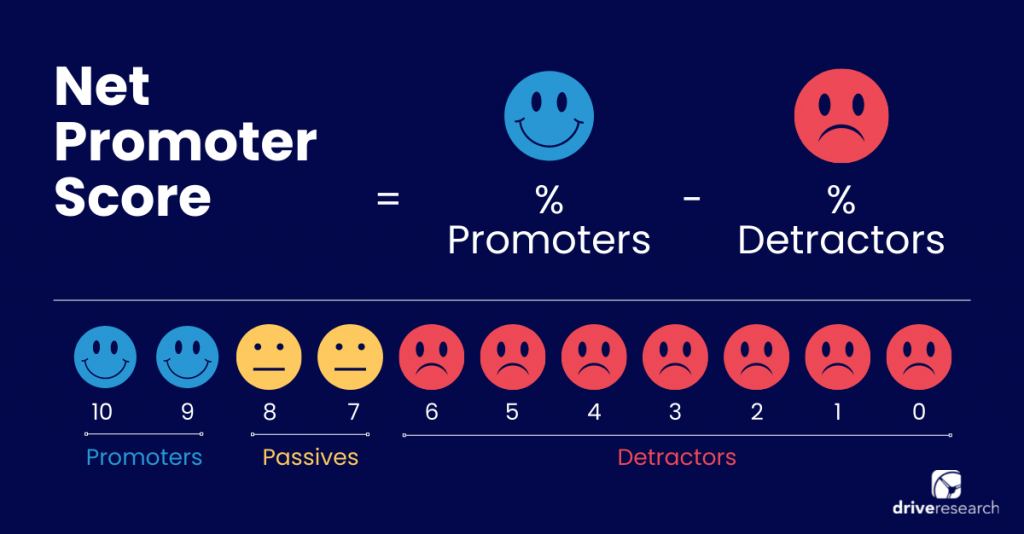
The value of calculating your organization’s net promoter score is important to measuring, benchmarking, and improving customer satisfaction.
Though, creating strategies to improve customer retention can only happen if you have a better idea of what a good net promoter score is.
While we dive more into how to know if your NPS is good, average, or bad below, I’ll start by saying this: average net promoter scores vary based on industry and business type.
Keep reading as we explore this customer satisfaction metric.
Recommended Reading: Ultimate Guide to Measuring Net Promoter Score
What is a Net Promoter Score?
Ok, but first, what exactly is a net promoter score? The NPS measures how likely someone is to recommend a company, product, or service to a friend, family member, or colleague based on previous experience.
NPS can be determined by asking survey respondents to select a rating on a 1 to 10 scale. “1” represents “not at all likely to recommend” and “10” represents “extremely likely to recommend.”
Based on the results, you can determine how many previous customers will promote your company, product, or service.
NPS is divided into three categories:
- Detractors
- Passives
- Promoters
These are established by the score that is given by respondents. Our market research company walks through each category and sees what each score means.
To determine what your net promoter score is simply subtract the percentage of detractors from the percentage of promoters.
Detractors
Detractors are customers that won’t recommend your company, product, or service because they had a negative experience. In fact, they may speak ill of it.
Detractors are anyone who responded with a score between “1” and “6”.
While there could be a considerable difference in negative consumer attitudes from detractors, all of them are not likely to recommend your company, product, or service.
Passives
Passives are viewed as neutral customers. They selected scores of “7” or “8”. Passives are satisfied with what was offered but aren’t committed to being promoters.
They may seek competing companies, products, or services to completely fulfill their needs.
However, they are not likely to disparage you like detractors. Passives are considered the “movable middle” so understanding what will make them promoters can be very useful.
Promoters
Promoters are what every company hopes for. By giving a rating of “9 or 10”, they are likely to give an enthusiastic recommendation of your company, product, or service.
The next time they talk to a friend or colleague, they will be sure to mention the positive experience they had with you.
The Key Takeaway: NPS is made up of three major components: detractors, passives and promoters. Each component represents a demographic and how they score a company.
What is a Good Net Promoter Score?
After collecting all of the survey responses, you can calculate the NPS using the formula below.
NPS = % of Promoters – % of Detractors
Now that you have calculated your NPS, you can decide what actions, if any, are needed.

A “good” NPS is different for each business type and sector.
For example, in business-to-business markets, the average NPS is between 25 and 33.
Whereas, the average net promoter score for business-to-consumer brands ranges from 24 to 57.
While these scores are open to interpretation, here are some quick analyses of what each score range could indicate.
- (-) < 0: A negative NPS is a troubling sign for your company, product, or service. You currently have more detractors than promoters, meaning more customers are not going to recommend you versus those who are. Major changes are needed to reverse this dynamic.
- 0 < +40: A NPS above 0 but below 40 is an indicator that improvements are needed to increase the number of promoters. In other words, what are the changes that are going to make the biggest difference? Achieving this would elevate your product or service.
- +40 < +60: Scores between 40 and 60 are encouraging. Maybe some small improvements could be made to the product to add a few more promoters.
- +60 < +100: Net promoter scores above 60 are outstanding. Your company is hitting all the right buttons and customers are relishing its greatness.
Learn more about what companies with high NPS scores have in common from our friends at AskNicely.
The Key Takeaway: We consider any rating from +40 to +60 to be a good net promoter score. Anything below, and some work needs to be done–anything above +60 is excellent!
How to Improve Your NPS
Let’s say you’re not too pleased with your company’s NPS. Thankfully, this is a score that can always be improved!
Below, our net promoter score company covers some of the best ways to improve your score.
Regular Check-Ins
A way to ensure you have a good net promoter score is to conduct research regularly!
Gathering this type of information on an ongoing basis allows you to keep tabs on brand performance–which is precisely why we think it’s a must-have item to include in your marketing budget.
NPS or otherwise, market research is most effective when it’s conducted more than once.
This way you can resolve issues immediately, rather than waiting to address them on an annual basis.
Customer Service Quality
To get the NPS of your dreams, your customer service team has to be on their game at all times.
After all, that’s the basis of a great NPS.
But customer service isn’t just about being nice to customers.
First off, you’ll want to ensure your team is responsive. Responding promptly to consumer woes is a great way to get that NPS up.
Second, improving customer service weighs heavily on having a great online experience. You’ll want to make sure your website is updated and user-friendly.
Don’t Ignore the Passives
Lastly, never toss out the passives when it comes to your NPS. It’s normal to want to focus on reversing your trend of detractors – but, passives are closer to becoming promoters.
Focus on what changes you can make, big or small, that will move the needle.
Relevant data from this group can spur on ideas for improved customer service and help your company in the long run.
The Key Takeaway: Part of your net promoter score calculation is understanding how your brand can improve (even with a good NPS). Paying attention to certain factors will likely raise your score and improve your business as a whole.
Example Company: “Pizza Shop A”
Let’s walk through an example of how a company might use an NPS study!
Pizza Shop A conducts an NPS study with Drive Research. They want the study to help them better understand how customers feel about their business.
One of the questions in the study asks how likely would customers recommend Pizza Shop A to someone they know.
Respondents were asked to select a rating from “1” to “10”. As we discussed earlier, 1 means not at all likely, and 10 means extremely likely.
The study found that 60% of respondents gave a rating above a “9” and only 10% gave below a “6”.
Applying the terms mentioned above, 60% of Pizza Shop A’s customers are promoters and only 10% are detractors.
Using the NPS formula, Pizza Shop A’s NPS is +50 – a good net promoter score.
Pizza Shop A is encouraged but asks what it can do to increase its number of promoters.
Fortunately, the study included several other questions that will provide them with reliable data to make better decisions to achieve this.
For example, the study found that 90% of respondents would enjoy Pizza Shop A more if it increased its number of pizza toppings.
Pizza Shop A decides to increase its variety of toppings and will run another NPS study in the future to determine if it increased its number of promoters.
The Key Takeaway: The above example is a great description of how a company can learn from an NPS. Just because a business scores well initially doesn’t mean there’s nothing to glean from the data.
Final Thoughts
A “good” net promoter score varies by industry. Working with a customer satisfaction survey company can help to provide your team with industry and competitive benchmarks to see where your company stands.
Taking the time to measure and improve NPS with go a long way for your organization.
For instance, having your customers recommend your product or service to their friends and family can boost sales without increasing marketing costs.
In fact, recent research has found that 94% of consumers who leave a good company rating will recommend that service to others.
And who doesn’t want that?
Measure NPS with Drive Research
Several different studies can help you determine your NPS. Here at Drive Research, we offer a variety of services that can help your company chart its future.
The most common services for NPS studies are customer satisfaction and VoC (voice of customer) studies.
Other services are also available if you feel they may suit your business better. Reach out to us and we’ll develop a personalized strategy together.
Get started by contacting our team today.



